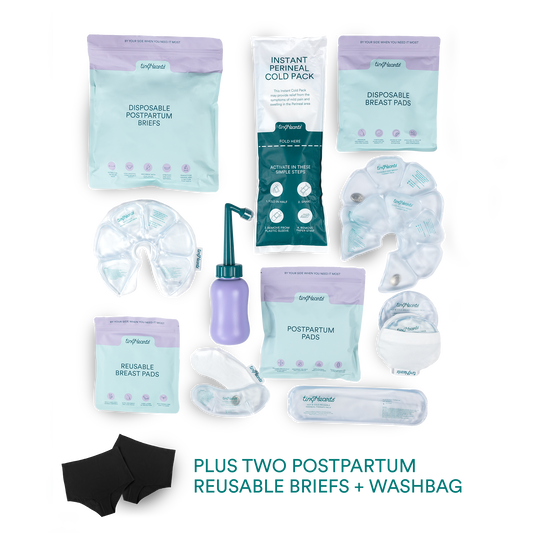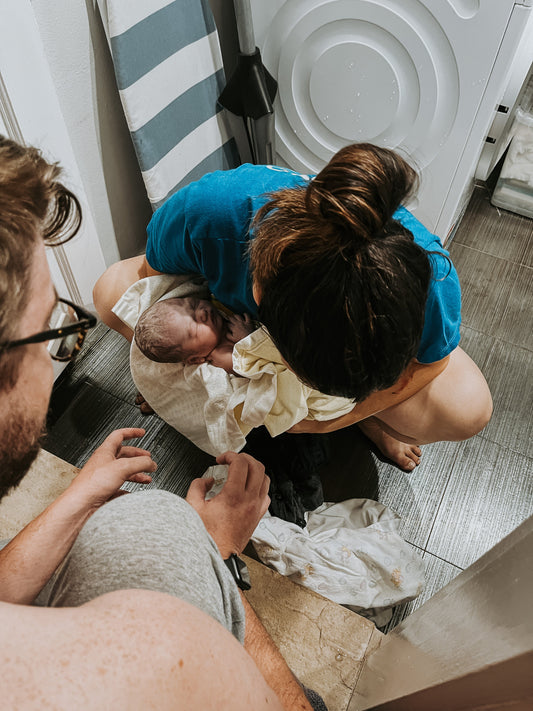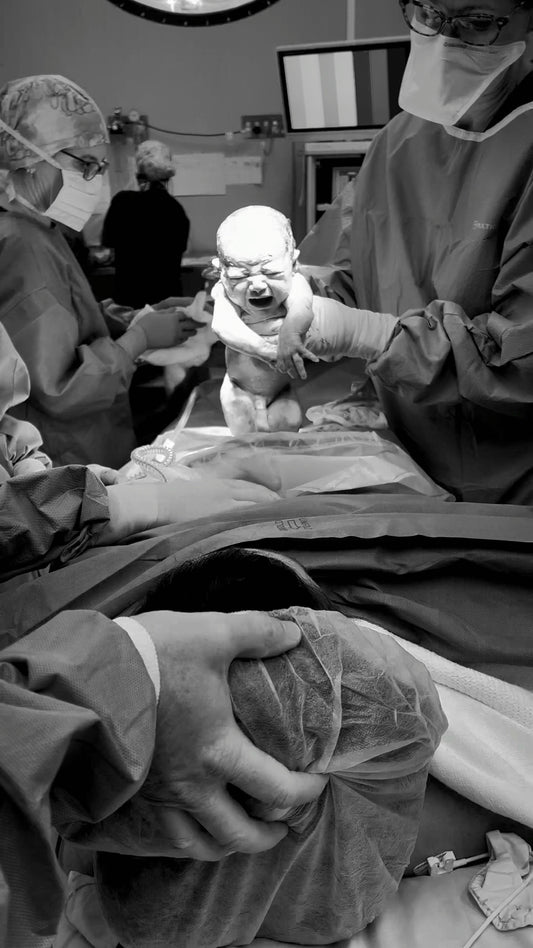Accidental homebirth: what to expect + what to do
Written by Jade | Midwife, Mama of 3 & Tiny Hearts Educator
Babies come when babies want; it's as simple as that.
Sometimes labour is a long and drawn-out process, but other times, labour is quick. Sometimes contractions are close together but short, while other times they're long but spaced out. Sometimes mamas feel contraction pain in their back, while others feel it in their front or deep in their hips.
The one thing that is a guarantee about labour is that it's unpredictable. One minute you might be sitting on the couch with some slight cramps, and an hour later, you're pushing out your newest little love.
Because of that, some parents might find themselves about to unexpectedly birth their bub at home when the original plan was to have bub in hospital. If that was the case, and you or your partner were about to have an unexpected home birth, would you know what to do?
To keep it simple, I've created two acronyms:
CATCH + HOPES
To prep for bub coming quickly, you need to:
CATCH
C: Call for help: Call 000. Tell the operator you [or your partner] is in labour, and bub is coming now. They will ask your address, your name, how many weeks pregnant you are/ your partner is, about the contraction intensity + frequency, if you/ your partner is pushing and if you can see or feel bub's head. They may also ask you a further series of questions. Try to answer the questions as accurately and succinctly as you can. And remember, while it may feel like they're wasting time in a time-critical situation, the questions they're asking you are to work out exactly what and how many resources they need to send you based on the situation.
A: Alone: Try not to be alone for this. Call or yell out to someone to come over immediately and be with you. It could be anyone; a neighbour, family member or a friend. Your priority should firstly be calling an ambulance, so if it's deciding between calling a friend and an ambulance, we recommend calling an ambulance first so that someone is definitely coming. But if you've got time, call around, or yell out to your neighbours for someone to come over. They'll come in handy for things like getting towels, opening the door for the ambulance and supporting you to birth bub.
T: Towels: Get some towels and blankets, and if you've got time, quickly chuck them in the dryer to warm them up. When bub is born, you'll need to dry them off and place a blanket over them and their mama to keep them warm.
C: Calm: Staying calm is so, so important. If you're birthing bub alone, take a deep breath and repeat these words, "I can do this because I am strong", and listen to what your body is telling you to do. If you're a support person, you might be even more stressed because you can see everything that's going on. But again, we can't stress enough what stopping and taking a deep breath can do. Your hands might be shaking, and your voice might break, but you need to be brave for yourself, your partner, and this new little person who is about to enter the world.
H: Heating: The environment needs to be warm for once bub is born. Depending on the climate you live in, the time of day, the season and the weather outside, consider closing windows, turning off fans or aircon, and turning on the heater. That's because little ones are at big risk of hypothermia [low temperature]. Being placed skin to skin on mama at birth can help, but remember, they come out wet and slippery, which could lead to them getting cold, particularly if under a fan, aircon or in the path of wind coming through a window.
If mama is pushing, you need to:
have high HOPES
H: Head: As a mama pushes, the presenting part [part that is coming out first] will eventually be able to be seen when the vagina starts opening. In the majority of cases, you'll see the back of a head coming, which may look like a hard, round object with or without hair. If a mama's waters haven't broken yet, it may also appear shiny and opaque in colour because bub's sac will still be over their head. If you see anything but a head, tell the 000 operator immediately. Other things it could be are a cord, bottom, foot, leg, fist or bub's face, and they'll instruct you what to do next.
O: Onto a surface: If you/ your partner is standing while is pushing, consider getting onto a surface in positions such as sitting, kneeling, side-lying, squatting or on all-fours on a surface to help yourself or your co-pilot catch bub. We know from research that upright positions during labour can be beneficial, and if standing is the only position that feels comfortable for a mama to push in, that's completely fine, but we'd recommend putting a pillow on the floor between her legs. That's because this is a high-pressure situation that the co-pilot probably doesn't do on a daily basis, so may not be used to what's about to happen. Plus, bubs, when born, are also really slippery, so having a pillow there acts as a backup in the very unlikely occurrence that they're a little bit too slippery, or a mama/ co-pilot wasn't expecting them to come out on that push.
P: Push: Once a mama enters the second stage of labour [pushing phase], they will get an overwhelming and uncontrollable urge to push. She might say things like "I feel like I need to poo" or "I'm pushing" or "bub is coming now" or "I'm feeling a lot of pressure in my vagina and bum-hole [anus] right now". At this point in birth, the body usually takes over, and a mama will push all on her own, even without actively meaning to. You may hear a mama grunt, yell, shout or groan with each push and some may go red in the face. You may also see a small amount of mucous come out, and probably some poo as well. If you haven't seen birth before, it may be confronting or overwhelming, but during the pushing phase of labour, this is all common and expected. And as a helpful hint, no, she doesn't need to know she's done a poo; just get rid of the evidence and never speak of it again 😂. At this point, it's also important to let the mama push - DON'T pull on bub's head to help them out. Make sure to tell the operator what's happening as it happens so they can update the paramedics who are coming to you as fast as they can.
E: Entrance: When bub does make an entrance, it may take a couple of contractions from the start of seeing their head to their head being completely out. On the next contraction, you should see bub's head rotate and their shoulders be born. Once the shoulders are out, their body should follow behind. Sometimes bub may be born tangled in the cord, so once they're out, untangle the cord from around bub and be mindful of it when moving little one in case it's short.
S: Skin to skin: Immediately after bub is born, place bub up on a mama's bare chest, so they're skin to skin, give them a good rub with a warm towel and keep rubbing until they give a big cry. Replace the wet towel with a blanket, keep bub on the mama's chest, don't cut the cord until help arrives and watch for signs the placenta is coming or bleeding from mama. If your little one is still blue and not breathing after a big rub, you need to resuscitate them, which the operator on the phone will support you to do until the ambulance arrives and takes over.
Tag your loved ones expecting a little one in this blog. Also, I'd love to hear from some of our Tiny Hearts parents on the original post; have you had an accidental home birth? And what was your experience like? 🤍
There's so much more info we'd love to share with you about pregnancy, labour, birth + newborn care. Check out our new Bump, Birth + Beyond course below and let us prepare you or refresh your memory in the best way for your journey into parenthood ahead. 💗
Bump, Birth & Beyond
$350
The Bump, Birth & Beyond course will educate you and your co-pilot (support person) on what to expect during pregnancy, birth and the first trimester with your new little love.
This course includes over 100 modules and LOTS of downloads including your very own Postpartum Plan!








